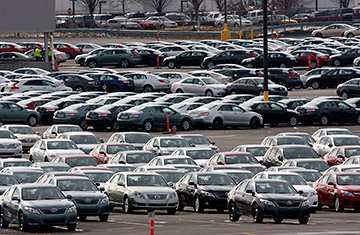
Toyota Camrys and Avalons at a manufacturing plant in Georgetown, Ky.
Transportation Secretary Ray LaHood told a congressional panel on Wednesday morning that people should stop driving their Toyotas, then later toned down his comment to a repair advisory. Maybe it's just Washington's new toughness in dealing with Big Business, but LaHood's shot was clearly a sign that respect for the king of cars is no longer in effect.
The damage done to Toyota by its recall of more than 5.3 million autos is clearly accumulating: U.S. sales dropped 16% in January, and the company's stock surrendered $21 billion in value in a single week. The latest development is the automaker's admitting to design problems with the brakes in its prized Prius. The Department of Transportation is threatening the company with fines for being slow to react to the problems — a pair of faults that can cause sudden, dangerous acceleration — though the DOT itself is being criticized for the same reason. Lawyers, who are never slow to react, are swarming. One class action alleges that jammed accelerators in Toyotas have caused 16 deaths and 243 injuries. Customers who once wouldn't think about looking at another brand now have reason to.
Toyota has now made two recalls in the U.S. The first, involving 4.9 million cars, was triggered by a problematic floor mat that could come loose and jam the gas pedal open. The second, of 2.3 million vehicles on Jan. 21, concerned a problem with the gas-pedal mechanism itself. Toyota told drivers to remove the floor mats; its fix for the sticky pedal requires a free 30-min. shop repair. The DOT has urged owners of the 11 recalled models to use caution and get to a dealer. Still unknown: whether an electronic problem is also a culprit in sudden acceleration. Toyota says it isn't.
The parable of Toyota may be that the tortoise became the hare. Over decades, Toyota built its reputation and market share in tiny increments through its renowned "continuous improvement" method. In the Toyota mantra, quality was always first, because it led to lower costs, which would eventually lead to higher market share. Eventually.
But in the '90s, Toyota set out to become the world's top auto company. Being the best and being the biggest created a tension that Toyota couldn't resolve, says MIT operations expert Steven Spear: "If quality is first, it drives a certain set of behaviors. If market share is the goal, it drives a different set of behaviors." Even as Toyota was catching up to the global No. 1, General Motors, the reputation of its cars was slipping. Spear, who has apprenticed in Toyota factories, says the problem was that the "Toyota way" — in which knowledge accumulated by élite cadres of engineers and assembly workers over many years is shared across the company — was diluted by the demands of production. "Even in the late '90s, people in Toyota would say, 'This is going to bite us in the ass,' " says Spear. "They just didn't know when."
Now they do. "We have to strengthen quality control," says Shinichi Sasaki, executive vice president for quality. It's a startling admission from a company that made reliability its quest. Toyota will fix its manufacturing problem. Restoring its reputation is going to take a lot longer.
